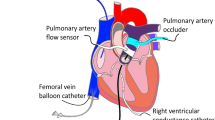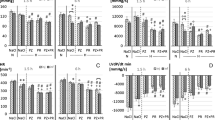Summary
In 14 closed-chest dogs, the significance of right ventricular filling for left ventricular enddiastolic pressure-volume relationship was investigated under acute hypoxia by means of single plane cineventriculography and simultaneous intraventricular pressure recording.
Both after 5 min asphyxia (respirator switched off) (n=5) and after 3 min hypoxia (ventilation with pure N2) (n=9), there was a significant leftward shift (p<0.005) of the left ventricular enddiastolic pressure-volume curve as compared to the control curves under normoxia. To simulate the elevated filling of the right ventricle under acute hypoxia, rapid intraventricular infusion was applier under normoxic conditions to raise right ventricular enddiastolic pressure to the same values as that measured under hypoxia. The extent of the ensuing leftward shift of the left ventricular enddiastolic pressurevolume curve was on average 60% of the shift under hypoxia in both sets of experiments. Neither the slope of the relationship between volume stiffness and enddiastolic pressure, nor the relationship between tangent elastic modulus and left ventricular wall stress, was affected by hypoxia or asphyxia.
Thus, the shift of the left ventricular enddiastolic pressure-volume curve in the early stage of hypoxia is predominantly due to the influence of increased right ventricular filling. Since the increased volume of the atria under acute hypoxia limits left ventricular distensibility additionally, the changes in left ventricular enddiastolic pressure-volume relationships, observed in the early stage of hypoxia are mainly, or even entircly, the result of interaction of the various heart compartments, and not a reflection of alterations in myocardial tissue elasticity.
Similar content being viewed by others
References
Alderman EL, Glantz SA (1976) Acute hemodynamic interventions shift the diastolic pressurevolume curve in man. Circulation 54:662–671
Barry WH, Brooker JZ, Alderman EL, Harrison DC (1974) Changes in diastolic stiffnes and tone of the left ventricle during angina pectoris. Circulation 49:255–263
Bemis CE, Serur JR, Borkenhagen D, Sonnenblick EH, Urschel CW (1974) Influence of right ventricular filling pressure on left ventricular pressure and dimension. Circ Res 34:498–504
Bernheim PI (1910) De l'asystolic veaneuse dans l'hypertrophie du coeur gauche par stenose concomitante du ventricle droit. Rev Med 30:785–801
Brilla C, Kissling G, Jacob R (1983) Determination of left ventricular diastolic wall stress and elasticity in situ. A methodological investigation. In: Jacob R, Gülch RW, Kissling G (eds) Cardiac adaptation to hemodynamic overload, training and stress. Steinkopff-Verlag, Darmstadt, pp 354–363
Cooley CA, Reul GJ, Wukasch CC (1972) Ischemic contracture of the heart: “stone heart”. Am J Cardiol 29:575
Diamond G, Forrester JS (1972) Effect of coronary artery disease and acute myocardial infarction on left ventricular compliance in man. Circulation 45:11–19
Dodge HI, Sandler H, Ballew DW, Lord JD (1960) The use of biplane angiocardiography for the measurement of left ventricular volume in man. Am Heart J 60:762–776
Elzinga C, Grondelle R, Westerhof N, van den Bos GC (1974) Ventricular interference. Am J Physiol 226:941–947
Forrester JS, Diamond G, Parmley WW, Swan HJC (1972) Early increase in left ventricular compliance after myocardial infarction. J Clin Invest 51:598–603
Glantz SA, Parmley WW (1978) Factors which affect the diastolic pressure-volume curve. Circ Res 42:171–180
Goto Y, Yamamato J, Saito M, Haze K, Sumiyoshi T, Fukami K, Hiramori K (1985) Effect of right ventricular ischemia on left ventricular gcometry and the enddiastolic pressure-volume relationship in the dog. Circulation 72:1104–1114
Henderson Y, Prince AL (1914) The relative systolic discharges of the right and left ventricles and their bearing on pulmonary congestion and depletion. Heart 5:217–226
Holubarsch Ch, Holubarsch Th (1979) Pflüg Arch ges Physiol 379, Suppl R 16
Holubarsch Ch, Jacob R (1980) Die “Compliance” des Herzens. Med Welt 31:136–144
Holubarsch Ch, Moser H, Jacob R (1980) Contracture type and fibrosis type of decreased myocardial distensibility. Different changes in elasticity of myocardium in hypoxia and hypertrophy. Basic Res Cardiol 75:244–252
Hood WB, Bianco JA, Kumar R, Whiting RB (1970) Experimental myocardial infarction. IV. Reduction of left ventricular compliance in the healing phase. J Clin Invest 49:1316–1323
Jacob R, Kissling G, Moser H, Schnizer W (1975) Zur Existenz einer hypoxischen oder regulativen Tonusminderung des Herzens. Verh Dtsch Ges Kreislaufforschg 41:267–271
Jacob R, Holubarsch Ch, Moser H, Brenner B (1980) Quantification and interpretation of changes in myocardial elasticity under hypoxia: Experimental models employing whole heart preparations and isolated muscle strips. Adv Clin Cardiol 1:211–228
Jacob R, Kissling G, Ebrecht G, Holubarsch Ch, Medugorac I, Rupp H (1983) Adaptive and pathological alterations in experimental cardiac hypertrophy. Adv Myocardiol 4:55–77
Jacob R, Gülch RW (1985) Mechanik des isolierten Herzmuskels. In Brüschke G (ed) Handbuch der Inneren Erkrankungen, vol 1/1. Gustav Fischer-Verlag, Berlin
Jacob R, Kissling G (1985) Dynamik des intakten Herzens. In: Brüschke G (ed) Handbuch der Inneren Erkrankungen, vol 1/1. Gustav Fischer-Verlag, Berlin
Janicki JS, Weber KT (1980) The pericardium and ventricular interaction, distensibility, and function. Am J Physiol 238:494–503
Janicki JS, Weber KT (1980) Factors influencing the diastolic pressure-volume relation of the cardiac ventricles. Fed Proc 39:133–140
Kübler W, Spieckermann PG (1970) Regulation of glycolysis in the ischemic and the anoxic myocardium. J Mol Cell Cardiol 1:351
Laks MM, Garner D, Swan HJC (1967) Volumes and compliances measured simultaneously in the right and left ventricles of the dog. Circ Res 20:565–569
Lorell BH, Palacios I, Daggett WM, Jacobs ML, Fowler BN, Newell JB (1981) Right ventricular distension and left ventricular compliance. Am J Physiol 240:87–98
Ludbrook PA, Byrne JD, McKnight RC (1979) Influence of right ventricular hemodynamics on left ventricular diastolic pressure-volume relations in man. Circulation 59:21–31
Marujama Y, Ashikawa K, Isoyama S, Kanatsuka H, Ino-Oka E, Takishima T (1982) Mechanical interactions between four heart chambers with and without the pericardium in canine hearts. Circ Res 50:86–100
Maughan WL, Kallman CH, Shoukas A (1981) The effect of right ventricular filling on the pressure-volume relationship of the ejecting canine left ventricle. Circ Res 49:382–388
McCans JL, Parker JO (1973) Left ventricular pressure-volume relationships during myocardial ischemia in man. Circulation 48:775–785
Mirsky I, Parmley WW (1974) Evaluation of passive elastic stiffness for the left ventricle and isolated heart muscle. In: Mirsky I, Ghista DN, Sandler H (eds) Cardiac Mechanics. John Wiley & Sons Inc, pp 331–358
Mirsky I, Rankin S (1979) The effects of geometry, elasticity, and external pressures on the diastolic pressure-volume and stiffness-stress relations. Circ Res 44:601–611
Mirsky I (1979) Elastic properties of the myocardium: a quantitative approach with physiological and clinical applications. In: Berne RM (ed) Handbook of Physiology. American Physiological Society, Washington DC, pp 497–531
Moser H (1977) Elastizität des Myokards bei Hypoxie. Dissertation Tübingen
Moulopoulos SD, Sarcas A, Stamatelopoulos S, Arealis E (1965) Left ventricular performance during by-pass or distension of the right ventricle. Circ Res 42:484–491
Rackley ChE, Dodge HT, Coble YD, Hay RE (1964) A method for determining left ventricular mass in man. Circulation 29:666–671
Ross J (1979) Acute displacement of the diastolic pressure-volume curve of the left ventricle: role of the pericardium and the right ventricle. Circulation 59:3237
Sandler H, Dodge HT (1968) The use of single plane angiocardiograms for the calculation of left ventricular volume in man. Am Heart J 75:325–334
Santamore WP, Lynch PR, Meier G, Heckman J, Bove AA (1976) Myocardial interaction between the ventricles. J Appl Physiol 4:362–368
Shirato K, Shabetai R, Bhargava V, Franklin D, Ross J (1978) Alteration of the left ventricular diastolic pressure-segment length relation produced by the pericardium. Effects of cardiac distension and afterload reduction in conscious dogs. Circulation 57:1191–1198
Schaff HV, Gott VL, Goldman RA, Frederiksen JW, Flaherty JT (1981) Mechanism of elevated left ventricular end-diastolic pressure after ischemic arrest and reperfusion. Am J Physiol 240:H300-H307
Stool EW, Mullins ChB, Leshin SJ, Mitchell JE (1974) Dimensional changes of the left ventricle during acute pulmonary arterial hypertension in dogs. Am J Cardiol 33:868–875
Taylor RR, Covell JW, Sonnenblick EH, Ross J (1967) Dependance of ventricular distensibility on filling of the opposite ventricle. Am J Physiol 213:711–718
Templeton GH, Wildenthal K, Willerson JT, Mitchell JH (1975) Influence of acute myocardial depression on left ventricular stiffness and its elastic and viscous components. J Clin Invest 56:278–285
Ullrich KJ, Riecker G, Kramer K (1954) Das Druckvolumendiagramm des Warmblüterherzens. Pflüg Arch 259:481–489
Vogt M, Jacob R (1985) Myocardial elasticity and left ventricular distensibility as related to oxygen deficiency and right ventricular filling. Analysis in rat heart model. Basic Res Cardiol 80:537–547
Weber KT, Janicki JS, Shroff S, Fishman AP (1981) Contractile mechanics and interaction of the right and left ventricles. Am J Cardiol 47:686–695
Wong BYS, Toyama M, Reis RL, Goodyer AVN (1978) Sequential changes in left ventricular compliance during acute coronary occlusion in the isovolumic working canine heart. Circ Res 43:274
Author information
Authors and Affiliations
Additional information
Supported by the Deutsche Forschungsgemeinschaft
Rights and permissions
About this article
Cite this article
Brilla, C., Kissling, G. & Jacob, R. Significance of right ventricular filling for left ventricular enddiastolic pressure-volume relationship under acute hypoxia in the dog. Basic Res Cardiol 82, 109–122 (1987). https://doi.org/10.1007/BF01907059
Received:
Issue Date:
DOI: https://doi.org/10.1007/BF01907059




